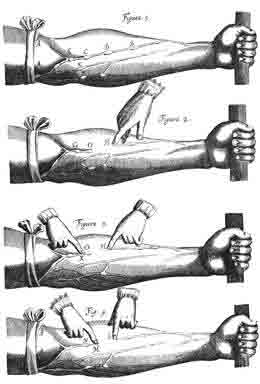William Harvey
1578-1657
 William Harvey was an English physician who was the first in the Western world to describe blood circulation. He provided in detail the direction of circulation and the properties of blood as it was pumped by the heart through the body. This discovery led to a shift in thinking about the origin of strokes. Prior to Harvey’s theory, strokes or apoplexy were understood from within humor theory as a blockage in flow of animal spirits in the body. With Harvey’s theory, strokes were reinterpreted as being caused by a cardiovascular blockage.
William Harvey was an English physician who was the first in the Western world to describe blood circulation. He provided in detail the direction of circulation and the properties of blood as it was pumped by the heart through the body. This discovery led to a shift in thinking about the origin of strokes. Prior to Harvey’s theory, strokes or apoplexy were understood from within humor theory as a blockage in flow of animal spirits in the body. With Harvey’s theory, strokes were reinterpreted as being caused by a cardiovascular blockage.
Harvey was educated at Cambridge and trained in medicine at Padua, Italy. Harvey returned to London and became physician to St. Bartholomew's Hospital. In his lecture notes of 1616 he wrote: “So it is proved that a continual movement of the blood in a circle is caused by the beat of the heart" (Whitteridge, 1964).
Harvey later became court physician, and in 1628 published his treatise on circulation: De Motu Cordis. His views were based on experimental ligation (tying off the blood flow) of veins and arteries, his observation of the functioning of venous valves, and on his calculations of blood volume of the heart.

William Harvey’s experiment illustrating the venous valves (nodes or portals) and the unidirectional nature of emptying and filling.
Writings about Harvey
French, R. (1994). William Harvey’s natural philosophy. NY: Cambridge University Press.
Pagel, W. ( 1976). New light on William Harvey. NY: S. Karger.
Whitteridge, G. (1964). The Anatomical Lectures of William Harvey; E. & S. Livingstone Ltd.: Edinburgh and London, U.K., 1964.
